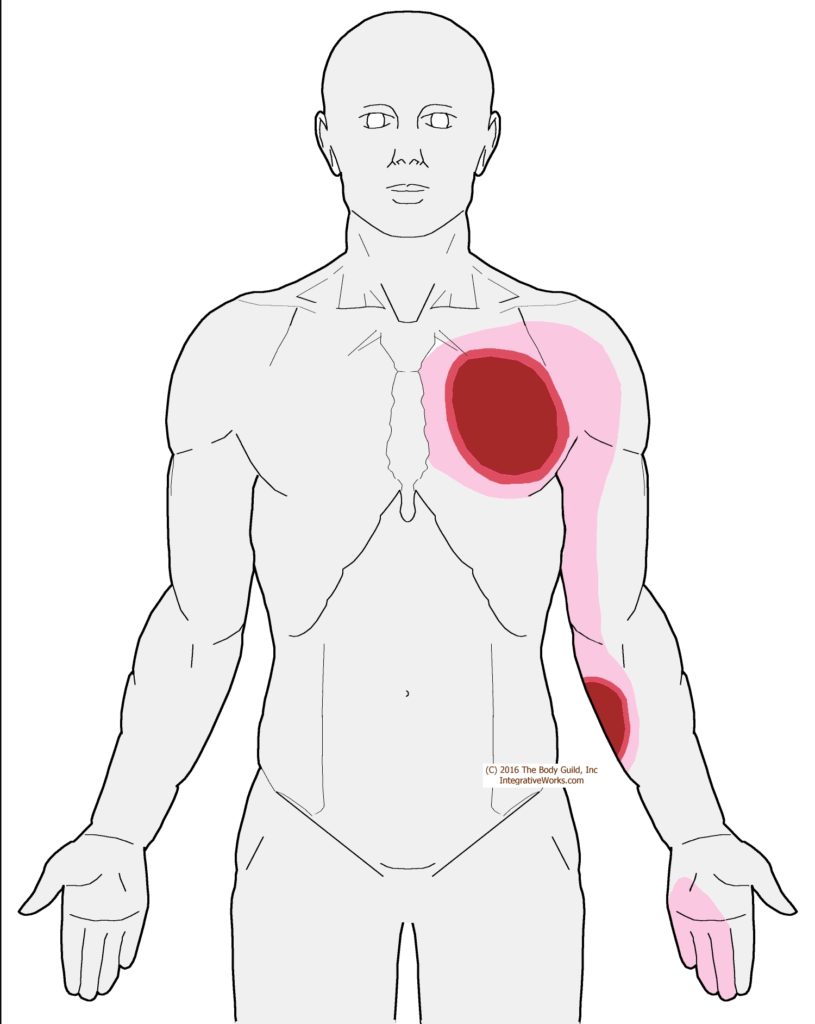Hard to Resolve Forearm Pain
How People Describe This Pain Pattern
Pain across the chest and down the arm is similar to the sensations of heart attack. Most of my clients have already checked with their heart specialist and tests show that they are OK. People with these symptoms need to check with a medical doctor before getting bodywork that may mask important indicators.


People usually complain of pain in the upper forearm. They actually grab or trace the area indicated in the picture. They will search for an activity that stressed the forearm but usually can’t come up with one. Some of my regulars will have already tried massaging and stretching the forearm.
Clients with this pattern of pain in the chest and arm usually find that is inconsistent but intense when it occurs. They have often adopted a slumped posture on that side that leaves slack in the sternal pectoral section. They may not have noticed that the pain pattern occurs when they roll that shoulder and arm back until that section stretches. Turning over in bed or leaving this shortened during sleep may wake them at night with chest or arm pain. If the pain becomes constant it is usually during these times of prolonged immobility.
How You Activate and Intensify This Pain Pattern
This can be onset by reaching forward at shoulder level. Recently, I had a client who was mounting a birdhouse on top of a post and held his arm forward at shoulder level for a period. This unusual activity is exactly the sort of thing that causes a latent trigger point to become more active combined with the sort of activity that aggravates this trigger point.
Getting Relief on Your Own
This post has strategies for getting relief on your own. Explore how to change your activities, stretch and other strategies that relieve the pain associated with this trigger point.
Therapy Notes for Massage and Bodywork
Better Bodywork Through Shared Expertise.
This post has techniques, tips, treatment routines, and anatomy illustrations to improve the bodyworker’s approach.
Support Integrative Works to
stay independent
and produce great content.
You can subscribe to our community on Patreon. You will get links to free content and access to exclusive content not seen on this site. In addition, we will be posting anatomy illustrations, treatment notes, and sections from our manuals not found on this site. Thank you so much for being so supportive.
Cranio Cradle Cup
This mug has classic, colorful illustrations of the craniosacral system and vault hold #3. It makes a great gift and conversation piece.
Tony Preston has a practice in Atlanta, Georgia, where he sees clients. He has written materials and instructed classes since the mid-90s. This includes anatomy, trigger points, cranial, and neuromuscular.
Question? Comment? Typo?
integrativeworks@gmail.com
Follow us on Instagram
*This site is undergoing significant changes. We are reformatting and expanding the posts to make them easier to read. The result will also be more accessible and include more patterns with better self-care. Meanwhile, there may be formatting, content presentation, and readability inconsistencies. Until we get older posts updated, please excuse our mess.